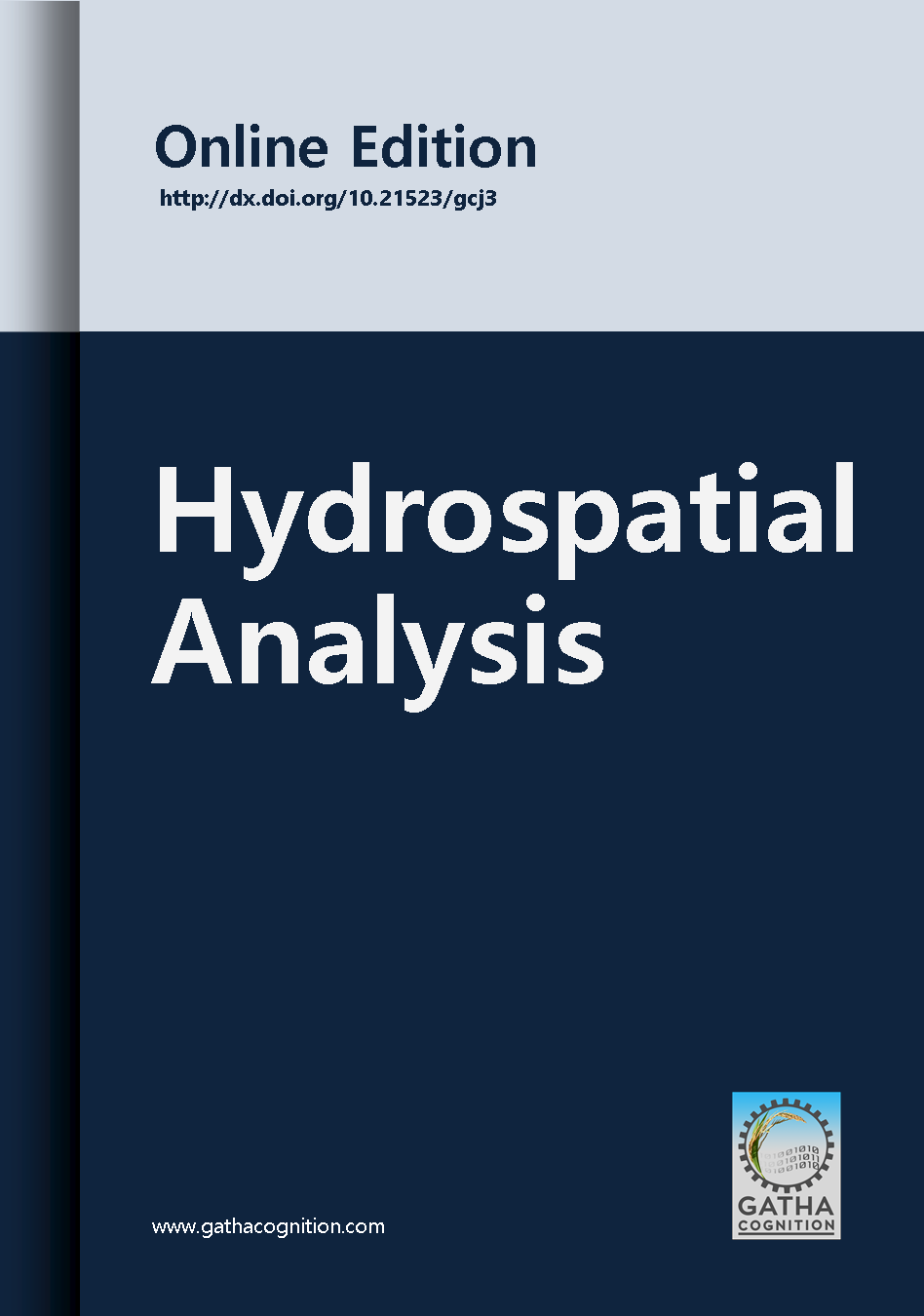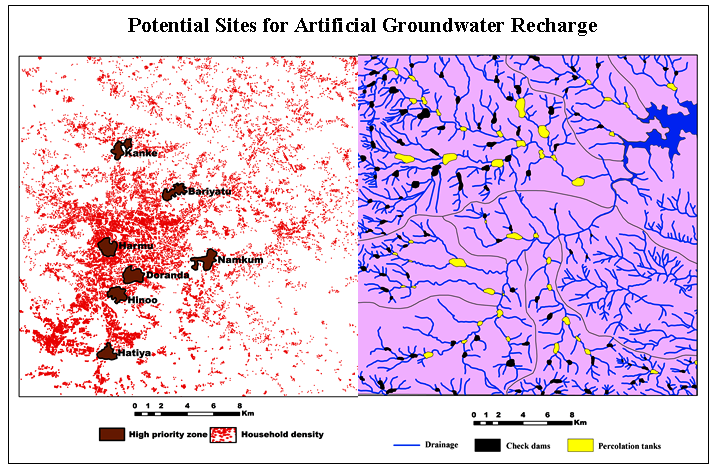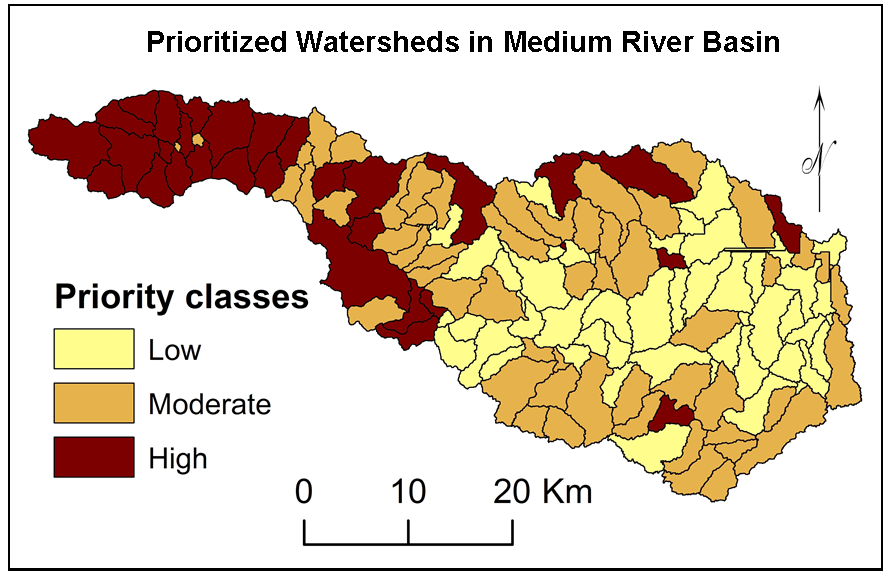Abstract
The Gumbel Extreme Value Type-I (GEVI) probability distribution is applied to investigate magnitude and frequency of floods on the Kaveri River using Annual Maximum Series data for 17 to 47 years. The GEVI is used for future probabilities of occurrences of floods and to estimate the recurrence interval of average annual peak discharges (\(\bar{Q}\)), large floods (Qlf) and actually observed maximum annual peak discharges (Qmax). The discharges have been estimated for 2-yr, 5-yr, 10-yr, 25-yr, 50-yr, 100-yr, 500-yr and 1000-yr floods that range from 9 to 10408 m3s-1. As per GEVI, the has a recurrence interval of 2.33 years, Qlf has 6.93 years. However, recurrence interval of Qmax range between 36 and 636 years. The curves portrayed on GEVI probability paper provide dependable estimates of floods. The GEVI probability distribution, therefore, can be reliably and conveniently used to estimate the recurrence intervals for given magnitude and vice versa.
1 . INTRODUCTION
Since pre-historic times, flooding, principally the destructive profusion of water (either freshwater or ocean), has been a key apprehension of people inhabiting the vicinity of rivers and water bodies (Kundzewicz and Schellnhuber, 2004). The United Nations Office for Disaster Risk Reduction (UNDRR) reported that over 2 billion people were affected by floods between 1998 and 2017 (Wallemacq and House, 2018). India, in particular, is extremely susceptible to the effects of flash floods, heavy rainfall events and tropical storms, that cause fatalities, damage to property and agricultural fields, and other undesirable effects on the environment, economy, and society (Kripalani et al., 2003; Dube and Rao, 2005). According to Natural Disaster Management Authority of India, out of the total geographical area of India (3287263 km2), more than ~ 400000 km2 i.e. 13% area is flood prone. Therefore, reliable estimation of the magnitude and frequency of floods are vital for management of floodplains, estimates of flood insurance and the design of transportation and water carriage structures, for instance, dams, bridges, culverts, etc. Flood frequency analysis, based on a set of systematic data and historical floods, is commonly used to relate the magnitude of extreme runoff or river flow events to their frequency of occurrence through the use of probability distributions. Stochastic methods for hydrological flood analysis were seminally introduced by Fuller in 1914 (Fuller, 1914). His exposition on flood frequency incorporated the return period as a quantitative measure for the recurrence probability of floods of varying magnitudes. Subsequent advancements by Foster (1924), Hazen (1930), and Gumbel (1941) expanded this approach to include the application of theoretical probability distribution functions, thereby modelling the empirical frequency distributions of flood events. These methodologies have since become entrenched in contemporary practices of probabilistic flood frequency analysis, as codified by the U.S. Water Resources Council in 1981 (Hirschbock, 1988).
Numerous probability distributions, for instance, Gamma (Pearson type III), Log Normal (LN), Log Pearson type III (LP III), Gumbel Extreme Value Type-I (GEVI), etc. are indorsed in the hydrological literature to determine hydraulic frequency, however, none of these distributions are documented as a universal distribution that can precisely signify the flood frequency (Law and Tasker, 2003) at any gauging site. Nevertheless, the objective of the present work is not to find out the most appropriate probability distribution(s), but to estimate the recurrence interval of high magnitude flows. Therefore, in the current paper, flood frequency analysis of the Kaveri River and its tributaries has been carried out by applying the GEVI distribution. The GEVI, also known as the extreme value distribution, is used to model extreme values (Gumbel, 1958; Haan, 1977; Todorovic, 1978; Watt, 1989; Coles, 2001; Castillo et al., 2005; Ferrari and Pinheiro, 2014). This distribution has been chosen primarily on the basis of its applicability to the monsoon-dominated Indian rivers (Hire, 2000; Hire and Patil, 2018; Patil, 2017; Pawar et al., 2020; Anwat et al., 2021). Besides, Garde and Kothyari (1990), on the basis of an investigation of long records available for 92 gauging stations, proposed the GEVI probability distribution for the Annual Maximum Series (AMS) data from Indian medium and large size catchments. Consequently, in view of the size of the Kaveri Basin and to understand the hydrological characteristics of floods in terms of magnitude and frequency, the GEVI probability distribution has been applied to the AMS data.
2 . STUDY AREA
The Kaveri River originates at an elevation of 1341 m at Talakaveri in the Bhramagiri ranges of the Western Ghat in the Karnataka State (Figure 1). The river flows to south east direction over the Mysore Plateau and debouches in the Bay of Bengal. The length of the Kaveri River is 800 km and it drains 81155 km2 area. The important tributaries of the river are the Hemavathi, Kabini, Shimsha, Arkavathi and Bhavani. The Kaveri Basin is flanked by the Western Ghat to the west, the Eastern Ghat to the east and south and to the north it is detached by the ridges separating from Krishna and Pennar Basins. The two major physiographic domains of the Kaveri Basin are the elevated Mysore Plateau characterised by broad valley and low gradient streams in the west and the fluvial-deltaic or Tamil Nadu Plains to the east (Kale et al., 2014).
The Kaveri Basin is underlain primarily by Archaean-Proterozoic crystalline rocks, for instance gneisses, charnockites and granites (Sharma and Rajamani, 2001; Valdiya, 2001). In the eastern part of the basin, quaternary sediments are present mainly on the fluvial-deltaic plains of the Tamil Nadu state. Moreover, numerous north south and east west trending lineaments, faults and shear zones characterize the Kaveri as well as the adjacent basins (Vaidyanadhan, 1971; Valdiya, 2001; Ramasamy, 2006).
The basin is primarily influenced by southwest monsoon in the Karnataka and Kerala states and northeast monsoon in the Tamil Nadu state. The average annual rainfall of the Kaveri Basin is 1172 mm. It varies from >2500 mm in the headwaters i.e. Western Ghat to ~700 mm in the lower reaches (Kale et al., 2014). More than three fourth of the annual rainfall and runoff of the basin arises during the southwest monsoon season and the wet season transports approximately 85% of the yearly sediment load (Vaithiyanathan et al., 1992). The average annual runoff of the Kaveri Basin (~21.4 km3) (Central Water Commission, 2020) is much less than other large rivers of the Peninsular India, for instance, the Godavari (111 km3), the Krishna (78 km3), the Mahanadi (67 km3) and the Narmada (46 km3). It, therefore, impels exceedingly low unit discharges and rates of erosion (Kale et al., 2014).
3 . DATA AND METHODOLOGY
The AMS data from 1971 to 2019 recorded at gauge and discharge (G/D) sites have been acquired from the water year book of 2018-19 published by Central Water Commission (2020) and were used to accomplish Flood Frequency Analysis of the Kaveri River and its tributaries. The record lengths of the data are from 17 to 47 years. The data were available for the Kudige, Kollegal, Biligundulu, Urachikottai, Kodumudi and Musiri sites on the Kaveri River and eight sites on its tributaries (Figure 1). In order to estimate discharges of a given return period, a frequency distribution is compiled from the data series of annual maximum events. The probable design flood discharges have been calculated for return periods of 2-yr, 5-yr, 10-yr, 25-yr, 50-yr, 100-yr, 500-yr and 1000-yr by means of the GEVI probability distribution. The distribution has also been employed for approximation of the recurrence interval of average annual peak discharge ( \(\bar{Q}\) ), large flood (Qlf) and actually observed maximum annual peak discharge (Qmax). A visual check of the fit of the frequency distribution is probably the best way in determining how satisfactory an individual distribution fits the AMS dataset or which distribution fits “best”. Thus, flood frequency of all the sites of the Kaveri River and its tributaries are represented graphically (Figure 2, 3 and 4) which fairly represents the Kaveri Basin.
1.1 Gumbel Extreme Value Type-I (GEVI) Probability Distribution
The GEVI (Gumbel, 1941, 1958) probability distribution has been applied as a universal model of extreme flood events principally in the perspective of regionalization procedures and has been recognized as a rational approach to predict the flood recurrence interval (Al-Mashidani et al., 1978; Hosking and Wallis, 1997). The GEVI probability distribution is expressed as;
\(QT=\bar{Q}+[K(T)*\sigma Q]\) (1)
\(\bar{Q} ={ \sum{Q} \over n}\) (2)
\(\sigma Q = \sqrt { \sum{Q-\bar{Q} } \over n-1}\) (3)
where, QT = given return period’s discharge; QT = average of annual peak discharge; K(T) = factor of frequency and is the return period’s (T) function. K(T) values are obtained from the book ‘Hydrology in Practice’ (Shaw, 1988); σQ = AMS’s standard deviation.
The return periods (T) were computed for average annual peak discharge ( K(T) ), large flood (Qlf) and peak on record (Qmax) for all sites by using the formula given below.
\({1 \over T}=1-F(X)=1-exp[-e^ {-b(X-a)}] \) (4)
where, T = return period of a specified discharge; F(X) = probability density function (PDF) of an annual maximum series Q £ X; a and b = parameters allied to the moments of population of Q values. The parameters a and b are derived, as under, by equation (5) and (6).
\(b= {\pi \over { \sigma Q \sqrt{6}}}\) (5)
\(b= \bar{Q} - {y \over {b}}\) (6)
where, \(\bar{Q}\) = average annual peak discharge; sQ = annual peak discharge’s standard deviation; y = 0.5772.
1.2 Plotting Position and Frequency Curves
The plotting positions have been calculated using a variety of equations, nevertheless, Cunnane (1978) and Shaw (1988) argues that Gringorten’s approach is pertinent as it fits outliers more closely than other plotting positions. Consequently, by using the following equations (Gringorten, 1963), F(X) values were determined.
\(P(X)=1-F(X)= {(r-0.44) \over (N+0.12)}\) (7)
where, P(X) = the probability of exceedance; r = rank of flood magnitude; N = the number of observations of AMS.
In the Gringorten plotting positions, by judgment, a line can be constructed to fit the scatter. Notwithstanding, drawing the line mathematically is more appropriate. Creating confidence limits about the fitted line and its association between the AMS and the linearized probability variable is also essential, since the majority of AMS data are only available for a short period of time (Shaw, 1988). In the present work, the procedure given by Shaw (1988) has been adopted to fit the line mathematically and to construct the confidence limits. The plotted graphs are represented in Figure 2, 3 and 4.
4 . RESULTS AND DISCUSSION
A frequency distribution is amassed from a data series of AMS to estimate discharges of a given return period. Peak flows have been estimated for different return periods such as 2-yr, 5-yr, 10-yr, 25-yr, 50-yr, 100-yr, 500-yr and 1000-yr by using GEVI probability distribution and the estimated discharges are given in Table 1. Accordingly, the highest estimated discharge (10408 m3s-1) of 1000-yr return period was for the Musiri Site (Figure 1) on the Kaveri River in the Tamil Nadu state. Nevertheless, the peak discharge of 7690 m3s-1 magnitude was observed on the Kaveri River at the Musiri Site in the year 2005 (Central Water Commission, 2020). The recurrence interval for this discharge is 135-yr (Table 2). Astonishingly, the estimated discharges of given return periods of the Kaveri River are remarkably low as compared to other Indian Peninsular Rivers (Hire, 2000; Hire and Patil, 2018; Patil, 2017; Pawar et al., 2020; Anwat et al., 2021).
Table 1. Estimated discharges in m3s-1 for different return periods for fourteen sites on the Kaveri River and its tributaries (based on GEVI distribution)
|
SN
|
River
|
Site
|
Record Length
|
Return period (yr)
|
|
2
|
5
|
10
|
25
|
50
|
100
|
500
|
1000
|
|
1
|
Kaveri
|
Kudige
|
44
|
1132
|
1483
|
1715
|
2010
|
2237
|
2449
|
2968
|
3167
|
|
2
|
Kaveri
|
Kollegal
|
47
|
2264
|
3645
|
4555
|
5716
|
6610
|
7442
|
9481
|
10266
|
|
3
|
Kaveri
|
Biligundulu
|
46
|
2139
|
3315
|
4090
|
5078
|
5840
|
6548
|
8285
|
8953
|
|
4
|
Kaveri
|
Urachikottai
|
39
|
1235
|
2542
|
3404
|
4502
|
5349
|
6136
|
8066
|
8809
|
|
5
|
Kaveri
|
Kodumudi
|
46
|
1259
|
2501
|
3319
|
4363
|
5168
|
5916
|
7750
|
8455
|
|
6
|
Kaveri
|
Musiri
|
45
|
1570
|
3095
|
4100
|
5382
|
6370
|
7289
|
9542
|
10408
|
|
7
|
Hemavathi
|
M.H. Halli
|
36
|
476
|
933
|
1234
|
1618
|
1914
|
2189
|
2863
|
3123
|
|
8
|
Shimsha
|
T.K. Halli
|
39
|
334
|
559
|
707
|
895
|
1041
|
1176
|
1507
|
1635
|
|
9
|
Lakshmana-thirtha
|
K.M. Vadi
|
38
|
205
|
335
|
420
|
529
|
613
|
691
|
882
|
955
|
|
10
|
Kabini
|
T. Narasipur
|
47
|
1051
|
1497
|
1791
|
2166
|
2455
|
2724
|
3383
|
3637
|
|
11
|
Chittar
|
Sevanur
|
17
|
9
|
23
|
32
|
44
|
53
|
61
|
82
|
90
|
|
12
|
Bhavani
|
Savandapur
|
40
|
208
|
499
|
690
|
934
|
1122
|
1297
|
1726
|
1891
|
|
13
|
Noyyal
|
E-Mangalam
|
19
|
56
|
93
|
118
|
149
|
173
|
196
|
251
|
272
|
|
14
|
Amaravathi
|
Nallamaranpatty
|
40
|
408
|
1365
|
1996
|
2802
|
3422
|
3998
|
5413
|
5957
|
|
See Figure 1 for location of the sites; GEVI = Gumbel Extreme Value Type-I
|
Furthermore, an attempt has been made to find out the return periods of average annual peak discharge ( \(\bar{Q}\) ), large flood (Qlf) and actually observed maximum annual peak discharge (Qmax) by applying the GEVI distribution and result have been shown in Table 2. Unsurprisingly, as per GEVI distribution, the \(\bar{Q}\) has the recurrence interval of 2.33-yr. The Qlf, which is well-defined as a flow that exceeds one standard deviation above the average annual peak discharge ( \(\bar{Q}\) ) (Hire, 2000), has the return period 6.93-yr. The analysis further confirms that the return period of the actually observed peak discharge (Qmax = 5571 m3s-1) on the Amaravati River at the Nallamaranpatty is 636-yr which is high. It is interesting to note here that the Amaravati is a tributary of the Kaveri River having drainage area of only 9080 km2. Nonetheless, the Qmax of the river at the Nallamaranpatty is much higher. However, the recurrence interval of the Kaveri River at the Musiri site, the lowermost site just before the commencement of the Kaveri Delta, is 135-yr. This site has the upstream drainage area of 66243 km2. Moreover, some discharge gauging sites have much less return period of the Qmax (2325 m3s-1) e.g. the Kabini River at T. Narasipur is merely 36-yr (Table 2). The observed annual peak discharges have been plotted against the return period or F(X) values (plotting positions) on the Gumbel graph paper, designed for the GEVI probability distribution. The magnitude-frequency graphs (Figure 2, 3 and 4) show that, the fitted lines are fairly near enough to the most of the data points and, consequently, can be reliably and expediently used to read the recurrence intervals for a given magnitude and vice versa. Remarkably, in plot of the GEVI distribution, the actually observed peak on record (Qmax) falls well in vicinity of the fitted line. This means the return period of Qmax(s) of all the sites projected by the GEVI probability distribution are likely to be quite reliable. Nevertheless, at three sites on the Kaveri River, viz. Urachikottai, Kodumudi and Musiri, the data points of lower magnitude floods are away from the fitted lines (Figure 2d, e, f). It may be attributed to controlled discharges as these sites are positioned downstream of the largest dam on the Kaveri River i.e. the Mettur Dam (Figure 1). Nonetheless, as stated earlier, the higher discharges are fairly close to the fitted lines (Figure 2d, e, f). Therefore, the GEVI probability distribution is an appropriate probability distribution for these sites too.
Table 2. Return period of Q ̅, Qlf and Qmax for sites on the Kaveri River and its tributaries (based on GEVI distribution)
|
SN
|
River
|
Site
|
Record length
|
m3s-1
|
Return Period (Yr)
|
|
1
|
Kaveri
|
Kudige
|
44
|
\(\bar{Q}\) = 1196
Qlf= 1595
Qmax= 2265
|
2.33
6.93
55.74
|
|
2
|
Kaveri
|
Kollegal
|
47
|
\(\bar{Q}\) = 2515
Qlf= 4084
Qmax= 6414
|
2.33
6.93
43.56
|
|
3
|
Kaveri
|
Biligundulu
|
46
|
\(\bar{Q}\) = 2352
Qlf= 3689
Qmax= 6688
|
2.33
6.93
114.55
|
|
4
|
Kaveri
|
Urachikottai
|
39
|
\(\bar{Q}\) = 1473
Qlf= 2958
Qmax= 5855
|
2.33
6.93
78.74
|
|
5
|
Kaveri
|
Kodumudi
|
46
|
\(\bar{Q}\) = 1485
Qlf= 2896
Qmax= 6585
|
2.33
6.93
183.70
|
|
6
|
Kaveri
|
Musiri
|
45
|
\(\bar{Q}\) = 1847
Qlf= 3580
Qmax= 7690
|
2.33
6.93
134.69
|
|
7
|
Hemavathi
|
M.H. Halli
|
36
|
\(\bar{Q}\) = 559
Qlf= 1078
Qmax= 2172
|
2.33
6.93
96.20
|
|
8
|
Shimsha
|
T.K. Halli
|
39
|
\(\bar{Q}\) = 375
Qlf= 630
Qmax= 980
|
2.33
6.93
37.78
|
|
9
|
Lakshmanathirtha
|
K.M. Vadi
|
38
|
\(\bar{Q}\) = 229
Qlf= 376
Qmax= 681
|
2.33
6.93
92.22
|
|
10
|
Kabini
|
T. Narasipur
|
47
|
\(\bar{Q}\) = 1132
Qlf= 1639
Qmax= 2325
|
2.33
6.93
36.86
|
|
11
|
Chittar
|
Sevanur
|
17
|
\(\bar{Q}\) = 11.27
Qlf= 27.11
Qmax= 58.40
|
2.33
6.93
81.25
|
|
12
|
Bhavani
|
Savandapur
|
40
|
\(\bar{Q}\) = 261
Qlf= 591
Qmax= 1446
|
2.33
6.93
178.25
|
|
13
|
Noyyal
|
E-Mangalam
|
19
|
\(\bar{Q}\) = 62
Qlf= 105
Qmax= 175
|
2.33
6.93
53.64
|
|
14
|
Amaravathi
|
Nallamaranpatty
|
40
|
\(\bar{Q}\) = 582
Qlf= 1670
Qmax= 5571
|
2.33
6.93
636.58
|
|
\(\bar{Q}\) = average annual peak discharge; Qlf = large flood; Qmax = maximum annual peak discharge; GEVI = Gumbel Extreme Value Type-I (Figure 1)
|

 ,
Pramodkumar Hire 2
,
Pramodkumar Hire 2

 ,
Archana Patil 3
,
Archana Patil 3















